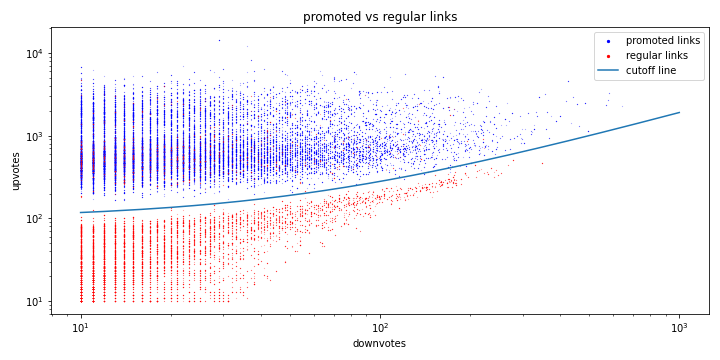
This is a continuation of the exploratory work of wykop.pl I started some time ago. This part focuses on voting strategies. Full data can be found here.
Intro
Previously, I identified two axes of tag/author variability: tag authorship composition spans from hierarchical to egalitarian and two tag size regimes. In this part, we continue with discussing voting strategies.
The voting system on wykop.pl is similar to other social media sites. Users vote for or against particular links or findings and state the reasons behind the decision. Depending on the overall sentiment, the link can be boosted (promoted) or not (treated as regular). We find some studies investigating similar voting systems. The present study is different in two important ways a) the mechanism of promotion is unknown and b) the system is transparent and publishes plenty of data like vote timestamps and voter credentials.
Our aim is to utilize the additional data to shed light on the promotion mechanisms, identify any suspect behavior of the voters, and identify patterns in the overall voting process. We work on a subset of tags that are selected as representative in the first part. Each tag contains links/findings with possible duplicates. Voting data contains voting users, vote timestamps, decision rationale, and types of votes.
Global voting characteristics
We first investigate the upvote/downvote ratio for individual links separated into promoted (blue) and regular (red). Both axes are plotted on a logarithmic scale.

We immediately observe a clear cutoff line separating the groups. We fit a simple cutoff line
\[n_\text{upvotes} = 100 + 1.8 \times n_\text{downvotes}\]
which quite clearly separates promoted and regular findings. Still, although we do not find promoted findings below the curve, separation of regular links is more ambiguous as we find some regular links above the line which we call anomalies. If the cutoff curve is a boundary for the promotion-finding classifier, such cases correspond to false positives:

From the point of view of any artificial voting strategy, false positives comprise interesting cases of links that did not get promoted despite acceptable upvote/downvote ratios.
Prevalence of anomalous links
We investigate how each tag is decomposed into:
- promoted links
- regular links above the cutoff (false positives / anomalies)
- regular links below the cutoff

We order them in descending order by the fraction of anomalous links. First, we observe that certain tags are more successful than others in producing promoted content. Easily understood examples of relative success are tags #putin, #rosja, #ukraina and #wojna, all treating the Ukraine war. We single out four most anomalous tags with increased fraction of false positives:
- #neuropa
- #energetyka
- #bekazpisu
- #wydarzenia
These stand out both in terms of the fraction of regular links above the cutoff, and, at the same time, comprising a large fraction of promoted links.
Types of voting trajectories
After tackling general features of votes within tags, we turn to an investigation of time-resolved voting trajectories for individual links. For each link, we take the whole history of upvotes/downvotes and form a curve in the upvote/downvote plane which show how an individual link gained votes during its lifetime on the website. This investigation revealed three basic types of trajectories depending on the relative changes in upvotes and downvotes.
-
hockey - initially, the voting trajectory hovers below the cutoff line and then gains an additional upvote momentum and shoots up above the cut-off line.
-
linear - both up- and down-votes increase in approximately constant proportion throughout the links’ lifetime; the crossing through the cutoff line does not affect this dynamic.
-
inverse hockey - initially, upvotes dominate over downvotes resulting in a fast crossing of the cutoff line, which only later saturates
On the same upvote/downvote plane as before but with linear scales, we present instances of all three trajectory types.

These types mirror the general popularity of the finding. In particular, we observe inverse-hockey types mainly concerning hot topics like the Ukraine war. Among all studied links, the most numerous are the hockey types while we find only a few linear cases. The hockey types are particularly interesting as there exists a time-localized impulse changing the voting dynamics and moving the finding above the cutoff line. Unfortunately, we cannot tell whether the impulse is a side-effect of the promotion being toggled or rather as a result of some external factor. The former explanation is in conflict with the presence of hockey-type trajectories in the anomalous link group. Still, this cannot be resolved since we do not have access to historical promotion data.
Inspection of trajectories in the promoted and anomalous/regular-above-cutoff link groups does not reveal any differences.

Conclusions
In this part, I looked at global voting characteristics. The main conclusions are as follows.
- In the upvote/downvote plane, there exists a simple linear cutoff line separating promoted and regular links
- Presence of anomalies, i.e. regular links, which, according to the cutoff line, should be promoted
- Three types of voting trajectories: hockey, linear or inverse-hockey depending on the dynamics of vote gains
- Types of voting trajectories are qualitatively the same within promoted and anomalous link groups
In the last part I plan to focus on informal user groups.